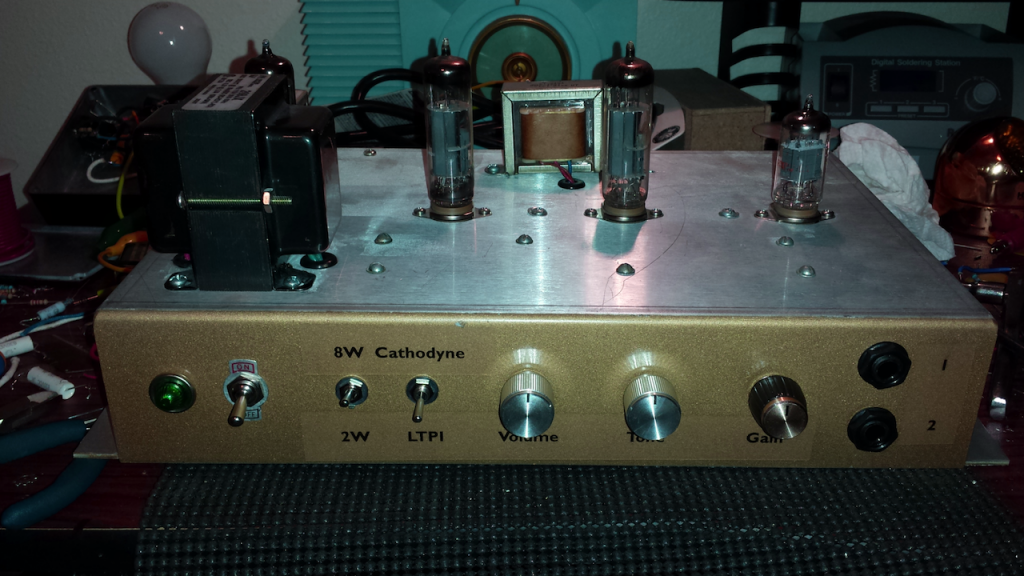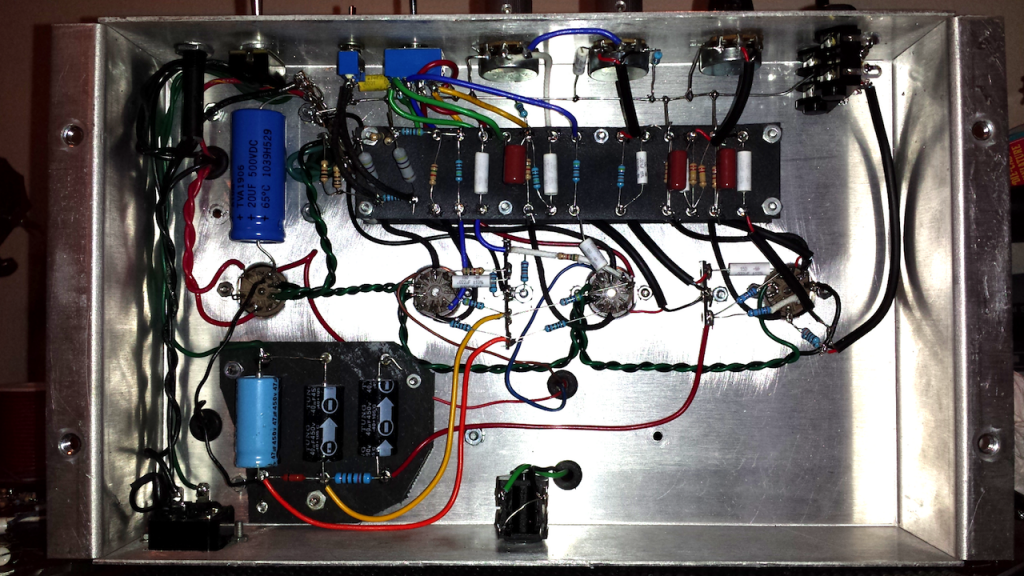Projects tend to grow. Evolve. Transform. Take on a life of their own. Some of them find bizarre ways of staying alive, or coming back to life after you think they’re long dead. Sometimes they start as one thing, become something else, and come around full circle to be what you started with in the first place. This is one of those “living” projects that just keeps on changing.
First there was a Firefly. It turned into a (very) low-power JCM800. Then it became the EF-Bomb. Then the EF-Bomb split into a high-voltage and low-voltage version. The high-voltage version became two. One became a mini 5F6A Bassman. The other became a test bench, which then became a “Ten Watt Vox” made entirely of pentode/triode combos. The Ten Watt Vox was sacrificed and became the original high-gain 8-watter. Then the unstable one-trick-pony high gain preamp got chucked in favor of a boostrapped 7199 pentode/CF preamp. It’s heavily rectified like a Marshall, Voxy with its LTPI and no NFB, and tweed Fendery with its cathodyne PI. Wait, did he really just mention two different phase inverters?
Yep, the phase inverters are switchable. In one mode, the preamp pushes into a fairly Vox-like LTPI. In the other mode, the preamp pushes another gain stage into a very Fender-like cathodyne PI. In either case it doesn’t take a whole lot to drive the sensitive ECL86 power pentodes.
Something that’s really neat about the 7199 in comparison to the EF86 is that it can put out 3 times the current. In this circuit I biased the 7199 pentode so that its idle (average) current delivery is greater than the maximum current draw of the 7199 triode cathode follower, even at grid conduction. This allows the pentode to “punch through” or “drive past” the typical gain restrictions presented by the rest of the circuit – instead of just clipping or hard-compressing at the current-driven limit, the pentode has the juice to actually push the cathode follower positive, yielding more harmonic overdrive than an EF86 can deliver. And that’s still before we get to the bootstrap.
Bootstrapping a DC-coupled cathode follower on a gain stage is a really neat trick – it involves splitting the first stage’s plate load into two parts (usually in half – it seems to be the “magic ratio”). The regular load output is sent to the cathode follower which acts as a load buffer. The output of the CF is then injected back into the plate load at that halfway point, which in turn “pulls up” the plate signal to 1.5x its original size. That larger signal goes back out to the cathode follower and takes another pass through the loop… eventually an equilibrium point is reached where increased current draw is causing enough compression to prevent any further increase in gain. Now remember how I biased the pentode to push out more current than the CF (load) can dissipate? The equilibrium point is never reached on its own, so this circuit can amplify until it runs out of supply voltage! For the sake of preserving the valve we have to keep the supply voltage low to prevent arcing and shorting our internal elements. The maximum heater-to-cathode rating of 200v, plus the heater DC elevation (10v), is almost exactly what I’m using as the B+ (212v).
The Gain control provides a variable boostrap between the pentode and cathode follower. The Gain pot is also a push/pull switch that puts the 7199 into what I call “effective triode” mode – as far as the AC signal goes it looks like a triode, but DC biasing (for both cathode and screen voltage) is completely unaffected. I’m not totally sold on its sonics though, so it may be replaced with something better.
Here’s a quick & dirty sound clip courtesy of my cell phone and a ’52 Tele Reissue in middle position. This shows the gain difference between Triode vs Pentode mode, Bootstrap vs no Bootstrap. The bootstrap adds a LOT of gain in pentode mode!







